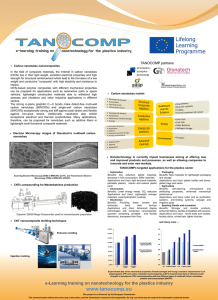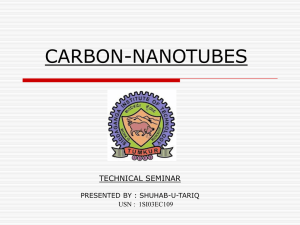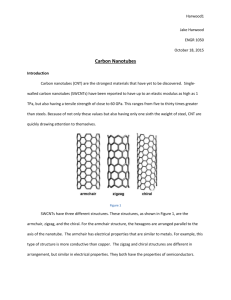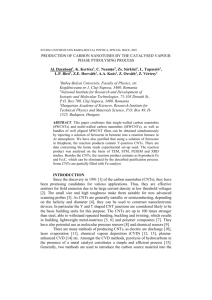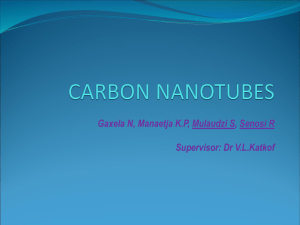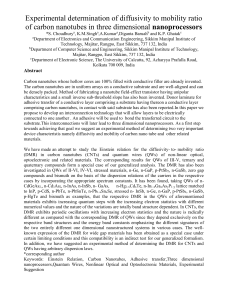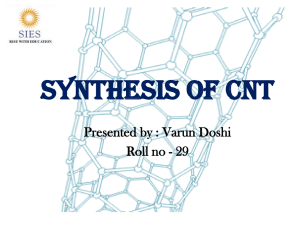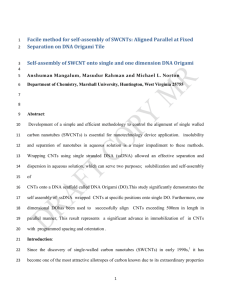PLANT BASED CARBON SOURCE - Institute for Environmental
advertisement
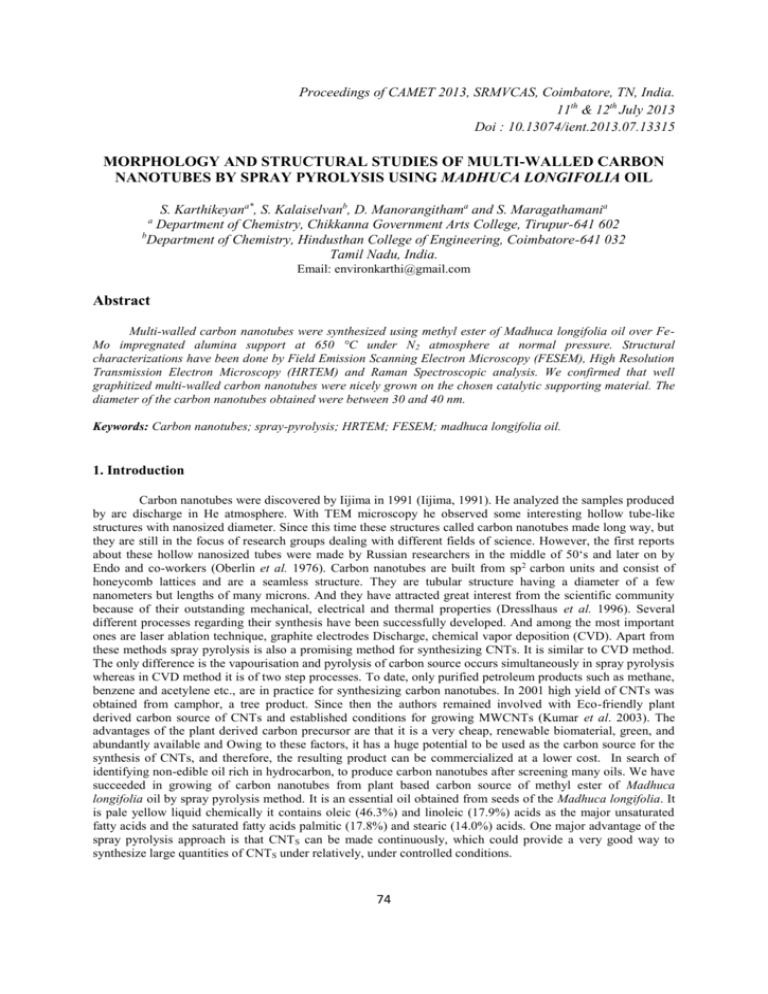
Proceedings of CAMET 2013, SRMVCAS, Coimbatore, TN, India. 11th & 12th July 2013 Doi : 10.13074/ient.2013.07.13315 MORPHOLOGY AND STRUCTURAL STUDIES OF MULTI-WALLED CARBON NANOTUBES BY SPRAY PYROLYSIS USING MADHUCA LONGIFOLIA OIL S. Karthikeyana*, S. Kalaiselvanb, D. Manorangithama and S. Maragathamania Department of Chemistry, Chikkanna Government Arts College, Tirupur-641 602 b Department of Chemistry, Hindusthan College of Engineering, Coimbatore-641 032 Tamil Nadu, India. a Email: environkarthi@gmail.com Abstract Multi-walled carbon nanotubes were synthesized using methyl ester of Madhuca longifolia oil over FeMo impregnated alumina support at 650 °C under N2 atmosphere at normal pressure. Structural characterizations have been done by Field Emission Scanning Electron Microscopy (FESEM), High Resolution Transmission Electron Microscopy (HRTEM) and Raman Spectroscopic analysis. We confirmed that well graphitized multi-walled carbon nanotubes were nicely grown on the chosen catalytic supporting material. The diameter of the carbon nanotubes obtained were between 30 and 40 nm. Keywords: Carbon nanotubes; spray-pyrolysis; HRTEM; FESEM; madhuca longifolia oil. 1. Introduction Carbon nanotubes were discovered by Iijima in 1991 (Iijima, 1991). He analyzed the samples produced by arc discharge in He atmosphere. With TEM microscopy he observed some interesting hollow tube-like structures with nanosized diameter. Since this time these structures called carbon nanotubes made long way, but they are still in the focus of research groups dealing with different fields of science. However, the first reports about these hollow nanosized tubes were made by Russian researchers in the middle of 50‘s and later on by Endo and co-workers (Oberlin et al. 1976). Carbon nanotubes are built from sp2 carbon units and consist of honeycomb lattices and are a seamless structure. They are tubular structure having a diameter of a few nanometers but lengths of many microns. And they have attracted great interest from the scientific community because of their outstanding mechanical, electrical and thermal properties (Dresslhaus et al. 1996). Several different processes regarding their synthesis have been successfully developed. And among the most important ones are laser ablation technique, graphite electrodes Discharge, chemical vapor deposition (CVD). Apart from these methods spray pyrolysis is also a promising method for synthesizing CNTs. It is similar to CVD method. The only difference is the vapourisation and pyrolysis of carbon source occurs simultaneously in spray pyrolysis whereas in CVD method it is of two step processes. To date, only purified petroleum products such as methane, benzene and acetylene etc., are in practice for synthesizing carbon nanotubes. In 2001 high yield of CNTs was obtained from camphor, a tree product. Since then the authors remained involved with Eco-friendly plant derived carbon source of CNTs and established conditions for growing MWCNTs (Kumar et al. 2003). The advantages of the plant derived carbon precursor are that it is a very cheap, renewable biomaterial, green, and abundantly available and Owing to these factors, it has a huge potential to be used as the carbon source for the synthesis of CNTs, and therefore, the resulting product can be commercialized at a lower cost. In search of identifying non-edible oil rich in hydrocarbon, to produce carbon nanotubes after screening many oils. We have succeeded in growing of carbon nanotubes from plant based carbon source of methyl ester of Madhuca longifolia oil by spray pyrolysis method. It is an essential oil obtained from seeds of the Madhuca longifolia. It is pale yellow liquid chemically it contains oleic (46.3%) and linoleic (17.9%) acids as the major unsaturated fatty acids and the saturated fatty acids palmitic (17.8%) and stearic (14.0%) acids. One major advantage of the spray pyrolysis approach is that CNTS can be made continuously, which could provide a very good way to synthesize large quantities of CNTS under relatively, under controlled conditions. 74 2. Experimental 2.1 Experimental setup The scheme of our home-made experimental spray-pyrolysis set-up used for the synthesis of carbon nanotubes is represented in Fig. 1. Fig. 1 The schematic diagram of spray pyrolysis set-up. (A) Heating source, (B) Spray nozzle, (C) Carbon feed stock inlet, (D) Nitrogen gas, (E) Quartz tube. One of the most important components of this experimental set-up is the sprayer (atomizer). The scheme of this sprayer is given in Fig. 2. The sprayer consists of a pyrex nozzle (capillary end of the inner tube) having an inner diameter of 0.75mm, and an outer pyrex tube which has an exit diameter of 2mm. This outer tube directs the carrier gas-flow (N2) around the nozzle. The inner tube of the sprayer is attached at one end to the solution (methyl ester of Madhuca longifolia oil) container. The other end of the nozzle is fixed to a quartz tube (reactor) by means of a polished glass-to-glass connection. The quartz tube has an inner diameter of 20 mm and it is placed in a 300 mm long electrical furnace. The quartz tube plays also the role of the support for the reaction products which appear pyrolytic decomposition of the starting materials (methyl ester of Madhuca longifolia oil) over Fe-Mo impregnated alumina support. The used electrical furnace is able to assure a uniform temperature up to 800 °C. Fig. 2 Schematic diagram of the Sprayer 1. Gas inlet; 2. Solution inlet; 3. Tightening; 4. Polished glassto-glass connection; 5, 6-Inner and outer pyrex tube. 2.2 Synthesis of Fe-Mo / Al2O3 Catalyst The alumina supported Fe/Mo catalyst was prepared by the metal ion impregnation method Fe(SO4)3 (0.3g alrich, technical grade) and (NH3)2MoO4 (0.04g with 99.95% purity) were dissolved in approximately 50 ml of deionised water, and approximately 2g of a alumina was added to the solution giving a Fe:Mo:Al 2O3 ratio 75 1:0.13:13. The water was removed by rotary evaporation, and the solid dried overnight in an oven at 100 °C the resulting powder was ground thoroughly using a mortar and pestle. 2.3 Experimental procedure The prepared catalyst was directly placed in a quartz boat and kept at the centre of a quartz tube which was placed inside a tubular furnace. The carrier gas nitrogen was introduced at the rate of 150 mL/min into the quartz tube to remove the presence of any oxygen inside the quartz tube. The temperature was raised from room temperature to 650 °C. Subsequently, the methyl ester of Madhuca longifolia oil (carbon precursor) was introduced into the quartz tube through spray nozzle and the flow was maintained at the rate of 0.2 - 0.5 ml/min. Spray pyrolysis was carried out for 45 minutes and thereafter furnace was cooled to room temperature. Nitrogen atmosphere was maintained throughout the experiment. 2.4 Sample characterization The morphology and degree of graphitization of the as-grown nanostructures were characterized by Field Emission Scanning Electron Microscopy (FESEM), High resolution transmission electron microscopy (HRTEM) (JEOL-3010), Raman spectroscopy (JASCO NRS-1500W) green laser with excitation wavelength 532 nm. 3. Results and discussions 3.1 Optimization of parameters for high yield For preparing CNTs in high yield using this technique, several experimental parameters were optimized. To explore the optimum growth temperature for the synthesis of CNTs, several experiments were performed in the temperature range 550 – 750 °C using the methyl ester of Madhuca longifolia oil and catalyst nanoparticles. Our experiments showed that, CNTs were formed in high yield at 650 °C. There is no clear growth of CNTs observed below 650 °C. because these temperatures are not enough to pyrolysis of carbon source and catalyst activity was also not enough. On the other hand, at higher temperature (750 °C), crispy deposit on the quartz tube surface contained amorphous carbon and hardly any CNTs. In this experiment, the optimized growth temperature was found to be 650 °C. Hence, further pyrolysis experiments for carbon precursor were carried out at this optimized growth temperature. Also, the flow rate of the precursor solution plays an important role for the growth of CNTs. The optimum flow rate of the precursor solution was found to be 0.5 mL/min. It has been observed that synthesis carried out at 650 °C with higher flow rate (1 mL/min) results in large amount of amorphous carbon and lower flow rate (0.1 mL/min) produces short CNTs together with amorphous carbon. 3.2 FESEM and HRTEM observations of CNTs Fig. 3 shows the Field Emission Scanning Electron Microscopy image of the as-grown nanostuctures over Fe-Mo bimetallic catalyst, impregnated in alumina at 650 °C under the flow of nitrogen by simple spray pyrolysis method. FESEM image clearly reveals that CNTs grew nicely on the surface of the alumina particles. Fig. 3: SEM and FESEM micrographs(From left) of as grown MWCNTs at 650 °C 76 Fig. 4 HRTEM micrographs of as grown MWCNTs at 650 °C a) a tubular structure with hollow inner b) magnified view on MWCNTs In Fig. 4a and 4b we have presented the high resolution HRTEM images of MWCNT S grown over FeMo bimetallic catalyst impregnated on alumina support at 650 °C with a flow rate of methyl ester of Madhuca longifolia oil at 0.5 ml per minute. Further, HRTEM image (fig. 4a) of the CNT S clearly confirms that the wall of the tube was clean and well graphitized. The catalyst particles present in the catalyst surface played a vital role for the formation of the CNT S. Most of the catalysts found to be decomposed in the growth of MWCNT S. . The well-graphitized wall of MWNTs with thickness about 12 nm and the inner and outer diameter of the tube thickness about 10 and 30 nm respectively. The diameters of the nanotubes were in the range of 30-40 nm. The walls of some tubes were so thick and inner diameters of those tubes were so small that the tubular structure sometimes cannot be observed clearly the multiple graphitic walls (≈ 20 walls) of the CNT S were clearly visible in HRTEM (fig. 4b), Similar phenomena were also reported previously [Luo et al.2005; Li et al. 2004]. 3.3 Raman spectroscopic analysis Raman spectroscopy was employed to characterize the crystalline nature of the as-synthesised MWCNTS. Fig. 5 typical Raman spectra of MWCNTs indicating two characteristic peaks. The G band peak at 1580 cm-1 corresponds to in-plane oscillation of carbon atoms in the graphene wall of MWCNTs and high degree lower D-band peak at 1356 cm-1 represents the degree of defects or dangling bonds. G-peak is assigned to E2g mode of graphite lattice and D-peak corresponds to an A1g mode due to the structural defects of the graphite crystal. The intensity ratio of D and G peaks (I D/IG) is used to characterize the degree of graphitization carbon materials, i.e., smaller ratio of ID/IG of the as-grown CNTs is ≈ 0.5. This value reveals a high degree of graphitization. 1580 1035 Intensity (arb.unit) 1356 2001 1000 1200 1400 1600 1800 2000 -1 Raman shift (cm ) Fig. 5 Raman spectroscopic analysis of as grown MWCNTs at 650 °C. 3.4 Growth Mechanism of MWNTs The mechanism of CNT nucleation and growth is one of the challenging and complex topics in current scientific research. Presently, various growth models based on experimental and quantitative studies have been proposed. It is well established, that during CNT nucleation and growth the following consecutive steps were taken place (Brukh et al. 2006). 1. Carbon species formation by decomposition of precursor over the catalyst 2. Diffusion of carbon species through the catalyst particle 77 3. Precipitation of the carbon in the form of CNTs The first step involves formation of carbon species by catalytic vapor decomposition of vapors of the precursor material over the catalyst. In the second step the diffusion of carbon species through the catalyst particle takes place. The third step is the precipitation of the carbon in the form of CNTs from the saturated catalyst particle. It is known from the fact that Catalytic centers on catalyst particle act as nucleation site for the growth of MWNTs (Lee et al. 2003). 4. Conclusion We have examined the simple and inexpensive method for the formation of MWCNT S by the decomposition of methyl ester of Madhuca longifolia oil using spray pyrolysis with a Fe-Mo / Al2O3 catalyst prepared by wet impregnation method. The present synthesis does not require any pretreatment of the catalyst precursor to increase its activity. A large number of available catalyst sites and efficient catalyst reactivity were the two crucial factors to control nanotubes growth. The resulting MWCNT S had a diameter ranging from 30 – 40 nm. Thus we have simply avoided toxic chemicals like acetylene, xylene and benzene and gas like CO and Hydrogen. Furthermore, this technique can be easily adopted for the synthesis of bulk CNTs. The simplicity of the process and the economy of utilizing a readily available, renewable green source renders this technique a significant potential for large scale commercial production of CNTs. Acknowledgment The authors acknowledge the UGC New Delhi for financial support, the Institute for Environmental and Nanotechnology for technical support and IITM for access to Electron Microscopes. References 1. 2. 3. 4. 5. 6. 7. 8. 9. Iijima, S., Helical microtubules of graphitic carbon, Nature. 354 (1991) 56-58. http://dx.doi.org/ doi:10.1038/354056a0 Oberlin, A., Endo, M., Koyama, T., Filamentous growth of carbon through benzene decomposition, J. Cryst. Growth, 32 (1976) 335-349. http://dx.doi.org/10.1016/0022-0248(76)90115-9 Dresslhaus, M.S., Dresslhaus, G., Eklund, P.C., Science of fullerenes and carbon nanotubes, Academic press, San Diego, (1996). Kumar, M., Ando, Y., Camphor ? a botanical precursor producing garden of carbon nanotubes, Diam.Relat. Mater. 12 (2003) 998. http://dx.doi.org/10.1016/S0925-9635(02)00341-2 Chen, X.Q., Motojima, S., Iwanaga, H., Carbon coatings on carbon micro-coils by pyrolysis of methane and their properties, Carbon, 37 (1999) 1825. http://dx.doi.org/10.1016/S00086223(99)00056-1 Luo, T., Liu, J.W., Chen, L.Y., Synthesis of helically coiled carbon nanotubes by reducing ethyl ether with metallic zinc, Carbon, 43 (2005) 755. http://dx.doi.org/10.1016/j.carbon.2004.10.048 Li, Y., Zhang X.B., Tao, X.Y., Growth mechanism of multi-walled carbon nanotubes with or without bundles by catalytic deposition of methane on Mo/MgO, Chem. Phys. Lett. 386 (2004) 105. http://dx.doi.org/10.1016/j.cplett.2003.12.128 Brukh, R., Mitra, S., Mechanism of carbon nanotube growth by CVD, Chem. Phys. Lett. 424 (2006) 126. http://dx.doi.org/10.1016/j.cplett.2006.04.028 Lee, M.H., Park, D.G., Preparation of MgO with High Surface Area, and Modification of Its Pore Characteristics, Bull. Korean Chem. Soc. 24 (2003) 1437. 78

